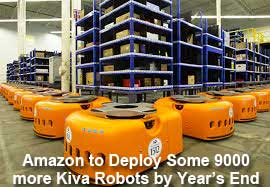Supply Chain News: Jeff Bezos Puts Hard
Numbers Behind Plans for Kiva Systems Robots at Amazon
10,000 or More to be in Its Fulfillment Centers by End of Year, Up Strongly from 1300 or So Currently
SCDigest Editorial Staff
Earlier this year, coming out of the MODEX show in Atlanta,
SCDigest exclusively reported that a senior manager at the Kiva Systems group
said Amazon would not be selling its bright orange, AGV-like robots to any
other companies for the next couple of years at minimum (see Amazon will not Make Kiva Systems Available to General
Market for at Least Two Years.)
That decision, the manager said, came after a recent review of the situation within the company. The bottom line was that meeting Amazon's own internal needs would basically consume Kiva's production and especially deployment capacities, leaving no room for servicing any other external customers.
Amazon
laid out a whopping $775 million to acquire Kiva in early 2012. Kiva was the
developer of an automated picking system, in which orange robots would
deliver goods to workers in pick cells, from which they would select
individual items to put into cartons or totes, often in efulfillment
operations.
In a sense, Kiva's solution can be said to have ushered in the "goods to picker" thinking that is manifesting itself in many ways in materials handling applications, especially but not exclusively for efulfillment. While the system can be deployed modularly, if it is taken to the full extent, with hundreds of Kiva robots moving around a DC, the very nature of traditional fulfillment operations is dramatically transformed. The move by Amazon to acquire a supply chain technology vendor was unusual, and led to speculation as to what the real drivers of the move were. Did Amazon, for example, want to keep the technology out of the hands of competitors such as Walmart.com? In general, Amazon has been very quiet about its intentions for Kiva, with the manager's comments in March to SCDigest being one of the first communications from the company on the topic. Now, Amazon founder and CEO Jeff Bezos has let a little more information out about its Kiva strategy. At a recent meeting with investors, Bezos said that by the end of the year, Amazon will have deployed some 10,000 of the Kiva machines - up about 8-fold from the 1300 or so now in Amazon fulfillment centers. At the meeting, Bezos said there about 1000 Kiva robots currently deployed, but last October, the company said it had 1,382 robots in three fulfillment centers. That would be a truly amazing ramp up - and makes it clear why you won't be seeing new Kiva robots in any other company's DCs any time soon. Kiva will likely be hard pressed just to keep up with Amazon's requirements, and that situation also makes it impossible for competitors to get any Kiva machines at the same time. | ||||||||
The manager in March told SCDigest that at that time at least,
the effort with Kiva was only going in to new Amazon fulfillment centers in
the US. So, none of the expected demand then was to retrofit existing
fulfillment centers - which would involve taking down tons of racking and
cause quite a disruption to existing operations - or yet for international
FCs, whether new or existing.
Marc Wulfraat of MWPVL International (and also an SCDigest expert columnist) keeps detailed track of Amazon's fulfillment center network. He says the company has at least 14 news FCs, totally a combined 11 million square feet, expected to be opened in North America in 2014.
It is not known
whether all of these facilities will be using the Kiva robots or just some of
them. Some back of the napkin math would say that if the 9000 additional
robots to be deployed this year were evenly spread across these 14 new
facilities, that would be 640 robots per FC. But that at this point is just a
mildly educated guess, and is significantly higher than the 400 or so per
facility implied by the number of installs cited by the company last October,
as noted above.
After Bezos' comments, an Amazon spokeswoman later said the
robot ramp-up won't affect employment level s or the rate of hiring in the
fulfillment centers. That seems a little hard to believe - else what is the
economic value of the Kiva robots?
But one explanation would then be that the Kiva system simply provides a lot more throughput with the same amount of workers, enabling Amazon to build smaller facilities, fewer fulfillment centers, or both, greatly reducing capital expenditures either way. SCDigest editor Dan Gilmore expects that whenever Amazon is largely past it roll-out of Kiva, it will sell the unit back off, either to a private equity company or to an existing materials handling company. Why? Beyond simply having taking its internal use about as far as it can, it seems likely that Walmart.com and others would not want Amazon staff in its DCs to install the systems, limiting Kiva's total market potential, perhaps substantially. But with the continued roll out of new FCs across the globe and the potential to upgrade many dozen other existing facilities, it is likely going to be a number of years before Amazon faces that decision. |
Wednesday, June 4, 2014
Subscribe to:
Post Comments (Atom)

No comments:
Post a Comment